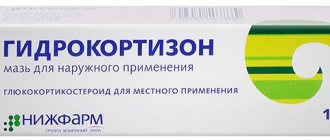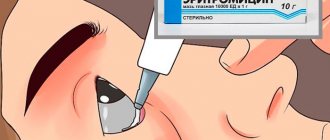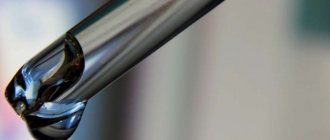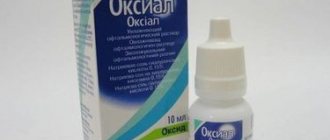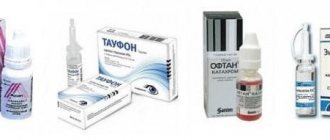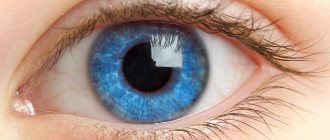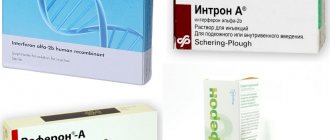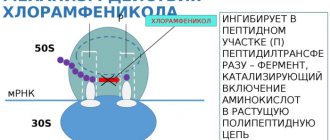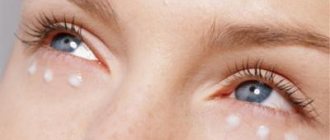The mechanism of allergy in the eyes
The development of dermatitis or conjunctivitis is determined by an immediate hypersensitivity reaction. Signs appear half an hour after encountering an irritating factor and disappear completely after 1-2 hours. The fact that the reaction appears on the eyelids is explained by the thin skin-muscle layer and the accessibility of the mucous membranes to direct contact with the virus. Treatment of allergies on the eyelids with ointment is carried out after visiting an ophthalmologist, who identifies the cause of the lesion.
Symptoms of irritation in the eye area:
- itching;
- burning;
- skin redness;
- edema;
- specific rashes.
Possible irritants are often called drugs, wool, cosmetics, pollen, food, book and house dust.
Types of ointments for allergies according to action
If symptoms appear, you should seek medical help.
After diagnosis, the doctor will offer an ointment, the effect of which depends on the cause that caused the mucocutaneous reaction.
The drugs come in two forms: some can be applied to the skin of the eyelids, others can be placed on the inner lower eyelid, and can be purchased at any pharmacy. The primary goal of treatment will be to relieve discomfort, pain in the eye area, reduce itching, and swelling. Therapy can be supplemented by taking antihistamines orally or by injections according to the scheme.
Hormonal
Creams containing hormones are prescribed as quick help to relieve severe allergies. The course of treatment is short: it can be completed in a few days or a week.
In the first days, a hormone-containing cream is applied in a thin layer to the area near or inside the eyelids up to 6 times a day. When inflammation decreases, they switch to twice-daily treatment. The products require a doctor’s prescription, there are many restrictions on use and contraindications: childhood, pregnancy, lactation.
Possible side effects of hormonal ointments during treatment:
- manifestation of spider veins;
- transient skin discoloration;
- withdrawal syndrome after long-term use.
The patient must be notified that the medicine relieves external signs of allergy and does not act on the root cause of the body's reaction.
Non-hormonal
Non-hormonal ointments and eyelid creams are prescribed to all categories of patients and children in the first year of life. The products take effect after some time.
Benefits of eye ointment therapy for non-hormonal allergies:
- eliminates itching;
- additionally has an antimycotic and antibacterial effect.
Drugs against viruses
Keratitis and conjunctivitis should be treated with antiviral drugs. Let's consider the most effective means of this group:
Pimafucin. This drug is a universal and effective remedy in the fight against ophthalmic diseases. It blocks the development of pathogenic microorganisms, thereby eliminating symptoms. Pimafucin ointment should be applied to the lower eyelid 3 times a day.
Oftalmoferon. This antiviral drug is available in the form of drops. It has an anti-inflammatory, antimicrobial and restorative effect on the mucous membrane of the eye. Thanks to this, it soothes the eye and relieves unpleasant symptoms. Oftalmoferon should be used at least 6 times a day, dropping 2 drops into each eye.
Tetracycline. Tetracycline ointment is intended to relieve inflammatory processes. This is an antibacterial drug that has a wide spectrum of action. Effectively fights viruses of various origins. Tetracycline ointment should be applied to the inside of the eyelid 3 times a day.- Bonafton. This ointment has an antiviral effect. Helps with severe forms of conjunctivitis. Bonafton eliminates such unpleasant symptoms as redness, itching, burning, etc. You need to use this ointment 3 times a day, placing it behind the lower eyelid.
Acyclovir. This drug is intended for the treatment of ophthalmic diseases caused by the herpes virus. Quickly relieves inflammation and symptoms. Apply the ointment to the inside of the lower eyelid 2 times a day.
Important to remember! Before using ophthalmic ointments in the treatment of viral diseases, it is better to consult a specialist!
Review of the best drugs for allergies on the eyelids
Hydrocortisone ointment based on a synthetically created hormone of the adrenal cortex removes inflammation: itching, swelling, redness.
Dex-gentamicin - a drug with the active ingredients dexamethasone and gentamicin sulfate - has a complex antibacterial and anti-inflammatory effect.
- irritation;
- eye infections;
- prevention of inflammation after surgery.
If allergic dermatoses are accompanied by roughening of the skin of the eyelids, Lorinden is used.
- flumethasoni pivalas;
- salicylic acid;
- propylene glycol;
- animal wax;
- petrolatum.
The drug relieves hyperemia and treats swelling at the site of inflammation.
When using Advantan ointment (the active ingredient is methylprednisolone aceponate), proliferation is reduced, which leads to minimization of erythema, swelling, weeping, itching, and pain.
Treatment with Fenistil (dimetindene maleate) shows an antihistamine and antipruritic effect. Reduces capillary permeability, itching and discomfort.
- antiallergic;
- decongestant;
- eliminating redness;
- cooling the skin;
- relieving pain;
- antipruritic.
Instructions for using eye ointment
Eye ointment (hydrocortisone, dex-gentamicin) is applied to the lower eyelid in a thin strip along the entire length (pupil directed upward). Then you need to blink frequently so that the medicine is evenly distributed throughout the eye.
When treated with drugs in the form of creams, the patient is advised not to wear contact lenses, but to use glasses to avoid allergic reactions.
Types and types of eye ointments
The category of eye ointments includes viscous products for the treatment of diseases of the eye structures, as well as the eyelids. The ointment combines medicinal preparations and lubricants (vaseline, purified animal fat, lanolin, wax), which mix well with the medicine, but do not react to it. These dosage forms have a long-lasting effect on the cornea, conjunctiva and eyelid skin due to the fact that they are distributed on the surface of the eye with a thin protective film. When prescribed, the amount of application is not metered.
Ointments are sold in convenient tubes and are usually equipped with a special tip or spatula for inserting into the conjunctival sac. They are applied to the skin of the eyelids with a sterile cotton swab.
All types of drugs can be divided into several main types.
- Antibacterial.
- Anti-inflammatory.
- Antiviral.
- Antiparasitic.
However, some combination formulations have complex effects. And it can be used as a relatively universal remedy.
Contraindications for use
Most of all, there are contraindications to the treatment of GCS for allergies.
Restrictions on the use of hydrocortisone:
- bacterial, viral, fungal infections of the organs of vision;
- eye tuberculosis;
- trachoma;
- pathology of the ocular epithelium.
Contraindications to the use of Dex-gentamicin eyelid ointment are keratitis, viral, fungal, purulent pathologies of the organs of vision, corneal lesions, age under 18 years, wearing contact lenses.
Contraindications to treatment with Lorinden for allergies:
- bacterial, viral, fungal infections of the skin;
- acute stages of skin diseases with weeping;
- lupus;
- syphilis;
- cancerous and precancerous conditions;
- acne vulgaris, rosacea;
- first trimester of pregnancy;
- childhood;
- allergy to components.
Advantan cannot be used to treat tuberculosis or syphilitic processes in the area of application, viral pathology in the treatment area, or rosacea. There is no need to treat the vaccination site. Do not use in the first 4 months of life and in case of hypersensitivity to the components of the ointment.
Limitations to treatment with La-Cri: high susceptibility to the components. Psilo-balm should not be used by pregnant or lactating women with an increased reaction to the components of the product.
Contraindications to eye ointment for allergies on the eyelids Fenistil:
- angle-closure glaucoma;
- proliferation of prostate tissue;
- newborns, premature babies;
- allergy to components;
- first trimester of pregnancy;
- lactation.
Top 10 drugs from the pharmacy
Antibiotic eye ointments actively suppress most types of known pathogenic bacteria and relieve existing inflammatory processes, restoring full health to a person. Among the best drugs for the treatment of eye diseases are several highly effective and fairly affordable drugs.
Tetracycline ointment
Indications for the use of this ophthalmic drug are such dangerous diseases as:
- Conjunctivitis.
- Blepharitis.
- Trachoma.
- Keratitis.
1 g of ointment contains 10,000 mcg of pure tetracycline. It is produced in tubes of 3.7 or 10 g.
The pharmacological effect of the drug is its fight against pathogenic microorganisms and the provision of a full bacteriostatic effect. However, in the case of viral conjunctivitis or the presence of a fungus, this ointment will be practically ineffective.
The drug is used according to the following scheme: it is placed behind the lower eyelid no more than 5 times a day.
The main contraindication to the use of the drug is human intolerance to tetracycline itself. A side effect of the drug is the occurrence of a local allergic reaction (burning in the eyes, swelling, itching). There were no episodes of ointment overdose. It is available without a prescription. The cost of the medicine is approximately 40 rubles. per package.
Ofloxacin
Antibiotic eye ointment containing 3 mg ofloxacin per 1 mg of its composition. Vaseline, methyl parahydroxybenzoate and propyl parahydroxybenzoate are also used as additional substances.
Ofloxacin has a unique mechanism of bactericidal action from a biological point of view, which manifests itself in a decrease in the activity of DNA gyrase, and this in turn stops the replication of bacterial DNA.
Indications for use of the drug are:
- diseases of the eyelids of bacterial origin.
- dacryocystitis, meibomitis;
- eye infections caused by chlamydia;
- prevention after various types of surgical interventions in the visual organs (eye injuries, removal of foreign bodies).
The drug must be used according to the following scheme:
- Carefully pull back the lower eyelid of the affected eye.
- 1 cm of ointment is injected into the conjunctival sac.
- Close the eye and rotate it to distribute the drug evenly inside.
This whole procedure is carried out 2-3 times a day for a period of no more than 2 weeks.
Side effects of using the ointment may include:
- burning and discomfort in the eyes.
- dryness, itching, fear of light.
- active lacrimation.
Clear contraindications to the use of the drug include:
- age up to 15 years.
- pregnancy and lactation.
- high sensitivity to the components of the ointment or intolerance to them.
There is no evidence of drug overdose. It is recommended to start driving a car no earlier than 15-20 minutes after putting the ointment in the eyes. The ointment is sold without a prescription at a price of approximately 60 rubles.
Phloxal
The drug serves to relieve inflammation in the eyes caused by diseases such as:
- blepharitis;
- barley;
- corneal ulcer;
- keratitis;
- chlamydial pathogen.
Eye ointment is placed inside the lower eyelid with a strip 1.5 cm long. The procedure is performed no more than 3 times a day. The course of treatment should not exceed 2 weeks. Parallel use of ointment and drops is allowed.
Floxal has a wide spectrum of action, which allows it to suppress gram-positive microorganisms.
Side effects of the drug may be:
- fear of light;
- discomfort in the eyes;
- dryness or, on the contrary, lacrimation;
- dizziness.
Pregnant and lactating women, as well as persons who are hypersensitive to the components of the ointment, should not use the drug.
There have been no cases of Floxal overdose. Do not wear contact lenses while using it. The drug is sold by prescription. The price is in the range of 140 – 190 rubles.
Erythromycin
The eye ointment is yellowish (in some cases yellowish-brown) in color. Contains 0.01 g of erythromycin.
The following are used as additional substances:
- petrolatum;
- anhydrous lanolin;
- sodium metabisulfite.
Erythromycin belongs to the group of macrolides and is able to be absorbed directly into the cornea of the eye, as well as into the watery structure of this organ.
The drug is prescribed if a person suffers from:
- blepharitis;
- meibomite;
- conjunctivitis;
- trachoma.
Persons suffering from kidney or liver failure are prohibited from using the drug. There are no clinical trials of the drug on its effects on pregnant and lactating women.
The drug must be used as follows: a strip of ointment no more than 1.5 cm long must be placed behind the eyelid of the diseased eye. This procedure is carried out 3 times a day. The duration of treatment depends on the specific disease and the severity of its course and therefore can range from 14 days to 4 months.
To combat trachoma, the drug is used 4-5 times a day with parallel opening of the follicles, and after the active inflammatory process has subsided, treatment follows the standard regimen.
The medication can be used to prevent blenorrhea in newborns. To do this, the ointment is placed behind the lower eyelid once a day.
An overdose of the drug has never been officially recorded.
Side effects of the ointment may include active lacrimation and impaired visual clarity. The drug is dispensed through pharmacy chains with a prescription from a doctor. Cost - about 90 - 100 rubles.
Hydrocortisone
An ointment containing the following components:
- hydrocortisone acetate;
- methylparaben;
- soft, white paraffin.
The preparation must have a uniform consistency. By itself, it has the ability to reduce inflammatory cell infiltrates, reduces the migration of leukocytes and lymphocytes in the area of inflammation. Hydrocortisone penetrates into the epidermis and epithelial layer of the mucous membrane.
The medicine is prescribed by a medical professional if the patient has:
- allergic conjunctivitis;
- iridocyclitis;
- keratitis;
- chemical burn;
- postoperative irritation.
Clear contraindications to the use of ointment may be:
- open glaucoma;
- fungal eye infections;
- eye tuberculosis;
- ulcers and wounds of the cornea;
- viral diseases of the visual organs;
- intolerance to the components of the drug;
- violation of the integrity of the structure of the eyeball;
- the patient's age is less than 18 years.
The effect of the drug on pregnant or lactating women has not been studied. There is no data on the penetration of glucocorsteroids into breast milk. Eye ointment is used locally: it is placed in the conjunctival sac in a strip up to 2 cm long no more than 3 times a day.
Side effects of the drug:
- short-term visual impairment;
- increase in eye pressure if treatment lasts more than 10 days;
- formation of subcapsular posterior cataract;
- decreased rate of healing of wounds that occur when the cornea thins;
- the occurrence of fungal infection.
Episodes of overdose are extremely rare and manifest themselves in the occurrence of local dose-dependent negative effects. If you stop using the drug, the manifestations of overdose disappear on their own. The ointment is available without a prescription at any pharmacy at a price of 30 rubles.
Posiformin
Eye ointments with an antibiotic, which is posiformin, are characterized by a broad antimicrobial effect. This drug contains 20 mg of bibrocathol in 1 g of its composition, as well as lanolin and mineral oil.
The drug is prescribed to persons suffering from:
- nonspecific irritations of the outer shell of the eyeballs;
- chronic blepharitis;
- fresh uninfected wounds of the cornea.
Posiformin provokes the deposition of proteins that bind the surface layers of tissues. Thus, a protective layer is formed that helps prevent the penetration of pathogenic elements. This becomes possible thanks to the presence of bibrocathol, which is a specific bismuth compound endowed with astringent and antiseptic properties.
Main contraindications to the use of the medicine:
- increased human sensitivity to the main or auxiliary components;
- age under 6 years;
- wearing contact lenses during treatment.
The ointment is used according to the following scheme: a strip 0.5 cm long is inserted into the conjunctival sac or onto the affected eyelid. The procedure is carried out up to 5 times a day. For adults and children over 6 years of age, the dosage is the same. Application period – up to 14 days.
An overdose is unlikely, since bibrocatol has a low degree of penetration through the biological membrane into the inside of the eye.
The use of the ointment by pregnant and lactating women is undesirable, since there is no accurate data on the degree of exposure of the drug to these categories of women. Posiformin is sold as prescribed (prescribed) by a medical professional. The cost of the drug is quite high - about 1900 rubles.
Tobradex
An antibiotic drug containing 3 mg of tobramycin and 1 mg of dexamethasone in 1 g of its composition. These eye ointments produced in Belgium also contain anhydrous chlorobutanol, mineral oil, and white soft paraffin.
The drug is prescribed when the patient has inflammation of the eyes with a bacterial infection, which is suppressed by blocking the ribosomes of harmful microorganisms, which reduces protein synthesis and the vital activity of the pathogen.
Tobradex is prohibited for use when a person suffers from:
- keratitis, which was caused by the herpes simplex virus;
- viral infections of the cornea and conjunctivitis;
- fungal eye diseases;
- microbacterial infections of the visual organs.
During pregnancy, the use of ointment is also prohibited because there is a risk of intrauterine growth retardation. Tobradex is non-toxic even if accidentally swallowed. Excess ointment in the eye is simply washed off with water.
Side effects often include:
- burning and itching;
- swelling and lacrimation;
- erythema;
- increased intraocular pressure.
However, these manifestations occur in only 1% of patients using the drug, which is sold by pharmacists exclusively by prescription. The price of the ointment is about 400 rubles.
Alfatex
An eye ointment containing the following main active ingredients:
- chloramphenicol;
- colistimethate sodium;
- tetracycline;
- betamethasone disodium phosphate.
The drug is prescribed to combat gram-positive and gram-negative bacteria, causative agents of various purulent infections, and affects rickettsia, spirochetes, and chlamydia. The ointment also has antifungal activity.
The drug is prescribed in cases of combating:
- conjunctivitis;
- keratitis;
- blepharitis;
- injuries and other damage to the visual organs.
Alfatex is used 3-4 times a day. It can be used in conjunction with eye drops, which are instilled in the morning, and the ointment is applied in this case in the afternoon.
Possible side effects:
- asthma attacks due to the presence of sodium sulfate in the ointment in people with acute sensitivity to this substance;
- increased intraocular pressure;
- posterior subcapsular cataract.
Prohibitions for using the drug are:
- glaucoma;
- viral diseases of the cornea;
- eye tuberculosis.
No cases of drug overdose have been identified. It is sold in pharmacies without a prescription at a price of about 2,000 rubles.
Colbiocin
Eye ointments with an antibiotic must also be considered with Colbiocin, which contains:
- colistimethate sodium;
- chloramphenicol;
- tetracycline;
- Vaseline oil;
- Vaseline for eyes.
This drug is a semi-solid liquid mass that is prescribed for:
- conjunctivitis (catarrhal, purulent, trachoma);
- blepharitis;
- bacterial keratitis;
- septic corneal ulcer;
- blepharoconjunctivitis;
- dacryocystitis.
The ointment inhibits the synthesis of proteins of harmful microorganisms and is active against gram-positive and gram-negative bacteria.
Unambiguous prohibitions on the use of the drug are:
- disorders of the kidneys and liver;
- pregnancy and lactation;
- age up to 8 years;
- intolerance to the components of the drug.
Side effects of Colbitsion:
- burning in the eyes;
- hives;
- short-term conjunctival hyperemia;
- bone marrow hypoplasia due to long-term topical use.
Eye ointment is applied to the lower conjunctival fornix up to 4 times a day. The drug is dispensed without a medical prescription from a doctor. The cost of the medicine ranges from 250 rubles.
Tsiprolet
An eye ointment that inhibits bacterial DNA gyrase and disrupts the synthesis and division of harmful microorganisms by destroying their membranes and cell walls.
The description of the drug is given in the table below:
| Compound | Diseases | Locked for reception | Side effects |
|
| Children under 2 years of age Hypersensitivity to existing components |
|
The drug is sold freely through pharmacy chains without a medical prescription, and its price starts from 50 rubles.
Modern eye drops are presented on the pharmacological market in a fairly large assortment. The exact selection of drugs with antibiotics for a sick person can always be carried out by his attending physician. The medical professional also determines the procedure for using the drug, the frequency of its administration and the duration of the course.
It is important to understand that if the ointment does not bring the desired effect after 3 days, then this is a serious signal that the drug needs to be replaced so that the negative consequences in no way increase from an existing infection of the visual organs.
Self-medication is also very dangerous, which can sometimes have a negative impact on the final result when it comes to getting rid of eye diseases.
When do you need eye ointment?
The need to use a local medication in humans arises in case of ophthalmic infectious and inflammatory diseases. Gels, drops and eye creams are widely used for eye ailments. The eye has a very sensitive surface, so any local drug must be selected correctly, following the indications, and after being prescribed by an ophthalmologist.
The eyelids can be subject to various inflammatory and infectious ailments. Ophthalmological diseases arise both due to external negative influences and internal pathologies. For almost every pathology there is an ointment, the purpose of which is to eliminate the causes and symptoms of the disease. As a result of the use of local drugs, you can get rid of the disease or alleviate the condition of the visual system. Indications for the use of eye ointments:
Varieties
To determine the causes of eye pathology, you need to consult an ophthalmologist and undergo a diagnostic examination. The doctor will select the necessary cream or gel that will be effective in treating the disease. Each medication has its own instructions, which should be read before using the drug. In ophthalmology, ointments for the eyelids have various therapeutic effects. The following types of local medications exist:
In the treatment of pathologies of the organs of vision, drugs of the antibacterial group can be used.
- antibacterial;
- anti-inflammatory;
- hormonal;
- decongestants;
- antiseptic;
- antiviral;
- with vitamin.
Return to contents
Antibacterial
Creams and drops of this group treat infectious and inflammatory eye diseases that are caused by intracellular microorganisms such as mycoplasma, chlamydia, and ureaplasma. Antibacterial ointment helps eliminate pathogenic bacteria, relieve irritation, swelling and itching, and get rid of infections. The drugs affect microorganisms of gram-negative and gram-positive types, help with ailments in which the causative agents are fungi. Such creams and gels are applied 2-4 times a day. The treatment course is 1-1.5 months. Good medications are erythromycin or tetracycline ointment. This absorbable eye ointment with an antibiotic does not sting; the wound-healing ointment “Rescuer” is also used.
Anti-inflammatory
Eye ointment for inflammation and redness eliminates inflammatory processes in the organs of vision and relieves puffiness. It has a calming effect and is used for allergies, colds or other types of inflammation. The duration of treatment depends on the characteristics of the disease. Anti-inflammatory ointment for eye treatment is used up to 4 times a day by placing under the lower eyelid area. You cannot stop therapy with drugs of this group on your own without the consent of the ophthalmologist, in order to avoid negative consequences. The best medications are Actovegin, Solcoseryl, thiamine ointment.
Hormonal
These drugs have anti-inflammatory, antiallergic and anti-edematous properties. They effectively help restore the organs of vision after injuries. However, such medications are dangerous - they can cause adverse reactions and have contraindications. Therefore, the course of treatment usually does not exceed 10 days. The drug should be used 2 times a day by placing under the lower eyelid. The best ointment in this group is hydrocortisone.
Decongestants
These drugs eliminate inflammation during swelling, restore water balance, and renew dermal cells. Decongestant ointment helps to activate lymph and blood flow, saturate the body with necessary beneficial elements and increase immunity. Before using such medications, it is necessary to exclude diseases of the kidneys, heart and pathologies accompanied by swelling. List:
Antiseptic
These drops or gel must be used for ophthalmic diseases accompanied by inflammation due to the proliferation of pathogenic bacteria. Infection in the eye area can occur due to viruses, fungi and bacteria. Depending on which microorganisms are the causative agents, the doctor selects the optimal antiseptic. The task of antiseptics is to stop the growth and reproduction of pathogenic microorganisms. After their use, the subcutaneous layers are normalized, metabolic processes are improved, recovery is accelerated and eye tissue is restored. Representatives of this medicinal group are healing ichthyol ointment, “Blefarogel”.
Antiviral
Medicines in this group relieve viral inflammation from the eyelids. Antiviral ointment affects adenovirus, herpes simplex. Means of this group should be used from 1 to 5 times a day, depending on the indications and condition of the patient. One of the best local medications is oxolinic ointment. The duration of treatment should not be more than 4 days.
Antifungal medications for eyes
Let's look at what drugs help fight the active activity of pathogenic fungi:
- Pimafucin. As already mentioned, this is a universal ophthalmic remedy that helps fight viruses.
It also contributes to the localization of active fungal activity. Pimafucin is used 3 times a day, applied to the inside of the lower eyelid.
This drug helps fight yeast fungi.
Candide.
To treat the eyes, you need to drop 2 drops into each eye at least 4 times a day.
This medication is intended for the treatment of fungal eye infections of various origins.
Kanizon.
Apply Kanison ointment 5 times a day to the inside of the lower eyelid.
Clotrimazole. This antifungal eye ointment helps slow the growth and development of pathogenic microorganisms.
Helps get rid of mold, yeast and protozoa. With regular use of Clotrimazole, the death of fungi occurs, which leads to complete recovery.You need to use the ointment 3 times a day, placing it behind the lower eyelid.
Fungorterbin Neo .
This medicine is intended for the treatment of infectious and fungal diseases. Quickly relieves symptoms of inflammation. Fungorterbin Neo is applied to the inside of the lower eyelid 3 times a day.
It is important to know! In order to get rid of ophthalmic diseases caused by the development of fungi, you need to contact a specialist to establish an accurate diagnosis!
List of drugs
The types of medicinal groups are presented in the table:
To treat the eyes, you need to prepare your hands by washing them.
- Before manipulation, wash your hands well and prepare a cotton ball.
- It is convenient to sit on a chair with a back, open the medicine, and tilt your head back.
- Raise your eyes up, pull down the lower eyelid.
- Squeeze a little product out of the tube and anoint it, being careful not to touch the eyelashes and mucous membranes.
- Close the eye and remove the excess portion of the drug with cotton wool.
- To distribute the drug over the conjunctiva, move the eye for 3-4 minutes.
According to the recommendations, the tube should be used individually to avoid transmission of infection.
It is strictly forbidden to apply the eye preparation using your finger. It is unacceptable to prescribe a course of treatment for yourself. The use of local ophthalmic medications can be carried out exclusively on the recommendation of an ophthalmologist after diagnostic examinations and after confirmation of the diagnosis.
Causes of facial allergies
Allergens can be different for each person, so it is impossible to accurately determine the causes for everyone. The most common are:
- food;
- medicinal;
- for clothing dyes;
- for dust and pollen;
- wool, fluff;
- on microscopic insects (dust mites and similar organisms).
The first two most often occur even in those who do not suffer from other types of allergies. There is no specific treatment for them; only avoidance of foods or medications that caused an allergic reaction will help. The remaining types are chronic; only antihistamines can save you from them.
Hormonal ointments
Any hormonal drug should only be prescribed by a doctor, because such active components affect not only allergies, but also organs and systems. Such drugs are strictly contraindicated for children under 14 years of age (only in case of urgent need, but not earlier than 2 years), pregnant and nursing mothers, and people with endocrine organ disorders.
The choice of hormonal ointments against allergies on the face is extensive; they are all highly effective, but can be used for different symptoms. Medicines of this class are divided into 4 groups, differing in the strength of their effect.
First group
Ointments of this group can be used against mild allergies on the face, which are manifested by slight redness, swelling of the eyelids and rash. Their activity is rather weak, so if there is a strong need, they are prescribed to pregnant women and children over 2 years old. The most popular ointments are:
- Hydrocortisone;
- Prednisolone.
Second group
This includes more effective drugs prescribed against facial allergies if ointments from the first group do not help. These remedies are used against severe swelling and redness of the eyelids, the appearance of a profuse itchy rash on the skin of the cheeks, forehead and chin. In the pharmacy such ointments can be found under the names:
Before using them, be sure to consult your doctor; do not apply them to allergies in children, pregnant women, or people with hormonal imbalances.
Third group
Ointments of the third group are used against severe inflammation, general swelling, flaky red spots and other severe manifestations of an allergic reaction. They have a powerful effect, so they quickly relieve dangerous symptoms. Also, these medications are used for eczema around the eyes and on the cheeks, allergic dermatitis and other chronic skin diseases. The list of the third group includes:
Another important property of these ointments is their high speed of action. Within 2-3 days after use, there will be no traces of an allergic reaction on the skin. These drugs cannot be used independently; if the dosage or selection of the drug is incorrect, they negatively affect the pancreas and liver.
Fourth group
These anti-allergy ointments are prescribed only in cases of severe need, exclusively by a doctor. Drugs of the fourth group have a high concentration of active ingredients and a very powerful effect, so dosage is important when using them.
These ointments are used against severe skin rashes, the appearance of weeping wounds that become crusty, and inflamed flaky areas. The active substances of these drugs penetrate as deeply as possible and have a very quick effect. This group includes:
Steroidal anti-inflammatory drugs
They are used for inflammatory processes in the eye caused by a number of reasons (viral and allergic conjunctivitis, choroiditis, keratitis, neuritis, iritis, etc.). The drugs have the ability to penetrate all tissues of the eye, including the lens, and enter the systemic bloodstream in small quantities. They quickly relieve swelling, eliminate inflammation, have a stabilizing effect on lysosomal membranes and mast cell membranes, and help reduce capillary permeability. The drugs are prescribed:
- for allergic symptoms;
- in case of acute inflammatory processes, not of bacterial origin;
- for viral infections.
However, these drugs are not used for violation of the integrity of the cornea, its ulcerations, and they are not indicated for bacterial infections. They are not intended for pregnant, breastfeeding women and children under 12 years of age.
Among the frequently used and well-proven drugs are the following drugs.
- Hydrocortisone eye ointment, it is widely used, is used for prolonged allergic conjunctivitis and viral infections of the eye. It can be found in pharmacies under the name Hydrocortisone eye ointment. A corticosteroid is similar to hormones produced by humans, and its long-term use leads to a decrease in the body’s own defenses (addiction). When using hydrocortisone, allergies (dermatitis, lacrimation, swelling and redness) go away faster. Already epithelized areas of the conjunctiva and skin damaged by burns or trauma are effectively restored.
- Dexamethasone is a synthetic corticosteroid. Its use is indicated for allergic conjunctivitis, as well as scleritis, iritis and keratitis, chorioretinitis and choroiditis, optic neuritis.
- Tobradex is a combination of a corticosteroid (dexamethasone) and an antibiotic (tobramycin), it has a broad spectrum of action and is used for most bacterial and viral infections, as well as for the treatment of post-operative infectious lesions of the ocular structures. The drug has a powerful effect on the microflora and structures of the eye. Do not apply without consulting a doctor.
You should always remember that any steroid eye ointment, including Hydrocortisone, is a very strong remedy; the instructions for use will tell you the nuances of use and possible side effects. If used incorrectly, this ointment can cause significant damage to vision.

